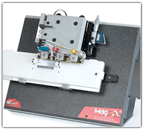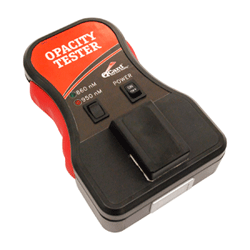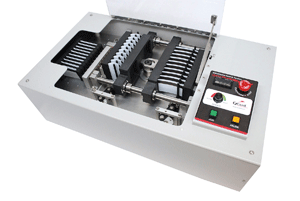Testing aims to make sure cards can stand the test of time
29 January, 2009
category: Contactless, Financial, Library, NFC

By Angela Tweedie, Contributing Editor
Imagine the stresses credit cards, ID cards and debit cards go through on a daily basis. Between constantly being taken in and out of wallets and purses, subjected to heat, and even run through the washer and dryer, the durability of plastic cards are put to the test every day.
But what most people don’t see are the rigorous tests that cards are put through before being placed in a wallet or purse. A battery of tests ensures that the product leaving the card manufacturer facilities is working properly and is in optimal condition.
Many card manufacturers purchase equipment that enables them to conduct the testing in-house, while others choose to go to a third-party testing facility to ensure that the testing is done in an unbiased environment with properly calibrated machines in good working order.
Sunsbury, Pa.-based Q-Card sells machines for card manufacturers to do their own testing but also performs the tests for the manufacturers. “A lot of the larger card manufacturers come to us to do their testing procedures,” says Ric Jones, a representative for Q-Card. “It helps keep the company honest and proves to the consumers that their products really are safe and have been properly tested. Both sectors of our business, the actual testing facilities and the testing equipment sales, are growing rapidly.”
Business is booming internationally as well. Q-Card opened an Asian division in 2007 to keep up with the growing Chinese manufacturing markets. “China is really an emerging market for manufacturing. They now offer their equipment in both English and Chinese in order to accommodate the demand,” says Jones.
 Q-Card tests to make sure that magnetic stripe cards conform to the necessary ISO standards. The company has and manufactures the equipment and technology used to produce the magnetic stripe reference cards. These cards are used to calibrate magnetic stripe analyzers during the manufacturing process of mag-based cards and tickets. The company also tests contactless smart cards.
Q-Card tests to make sure that magnetic stripe cards conform to the necessary ISO standards. The company has and manufactures the equipment and technology used to produce the magnetic stripe reference cards. These cards are used to calibrate magnetic stripe analyzers during the manufacturing process of mag-based cards and tickets. The company also tests contactless smart cards.
After the cards are produced and encoded card manufacturers pull some cards and send them to a testing facility to see if they meet the necessary specifications. “There are no minimums for testing at Q-Card, so some tests are performed on only one card,” Jones says. “The testing facilities are secure, and all the testing is done in-house to ensure that it has been conducted properly.”
Often when there’s a problem with a card, finger pointing will ensue. “You have a situation where all three entities [the manufacturer, the testing service, and the distributor] can all blame the other party, so Q-Card labs and equipment can ultimately determine where the fault really lies,” says Jones.
Another company involved in card testing is the Netherlands-based Collis. It offers services for testing, including EMV, contactless, near field communication and Single Euro Payments Area consulting and services. “Our activities are based on our TestGoal test philosophy and method, which includes the full spectrum of test activities such as test design and implementation, quality and test management, and reviews, inspections and audits,” says Valentyna Romanenko, marketing and communications officer for Collis.
Collis offers several different testing schemes, based on timelines, price and individual customer needs, Romanenko says. The company offers testing in its own facilities, testing in customers’ facilities, or a combination of the two.
In addition to smart card testing, Collis also specializes in electronic identification testing, including e-passports, e-ticketing, and e-health programs. Collis also offers consulting services that aid in implementing e-ID programs, Romanenko says.
Another player in the market is the U.S.-based Exponent Inc. The scientific and engineering consulting firm performs testing on smart cards, e-passports, bank cards, and a host of other industries that use mag-stripe and smart card technologies. Exponent has collaborated with the GSA to test smart cards as a part of the FIPS 201 program.
“We test cards both pre-issuance and post-issuance on behalf of companies when the product fails to work properly or fails to meet certain requirements. They have us evaluate it and we run it through a suite of compliance testing. On the post-issuance side we examine any card that defaults before the three-year lifespan,” says Brad McGoran, senior managing engineer for Exponent.
The smart card testing part of the business was established in 2000 when Exponent was supporting the U.S. Department of Defense on system and evaluation testing. A project had gone over budget and over time, and Exponent was called in to assist. The interest from other groups heightened, and Exponent was called in for support on the DOD Common Access Card issuance, which it has been doing for eight years.
On the pre-issuance side, Exponent runs the cards through a number of ISO and ANSI tests on the smart card chip. The company also performs tests on the durability of the card as well.
On the post-issuance side, Exponent looks at any CAC that fails before its three-year lifespan. The company analyzes the card and finds out why it failed and determines if any steps need to be taken to make sure other cards don’t fail.
 Q-card says most of its tests are performed in just a few minutes’ time. The standard tests run on contactless cards are performed on test validation and personalization. Other examinations include heat and flexibility testing, demagnetization, distortion, and data encoding testing on the cards.
Q-card says most of its tests are performed in just a few minutes’ time. The standard tests run on contactless cards are performed on test validation and personalization. Other examinations include heat and flexibility testing, demagnetization, distortion, and data encoding testing on the cards.
One of the most common problems that testing facilities look for is “jitter,” a problem that leads to card read error. “The main focus in mag stripe testing is various things that can introduce ‘jitter’ in a card, which causes failed transactions. It’s basically caused by magnetic particles being improperly coded in the magnetic stripe,” says Jones. Jitter is commonly caused by day-to-day activities or dirty magnetic reader heads, but is also caused by defects in the encoding process, which can be determined before the card hits the market.
While the actual testing may only take a little bit of time, the next step is to create a report to send back to the card manufacturer. “The process is generally about three weeks for a complete testing and submission of a report,” says McGoran.
After the cards are approved, they are sent out to the card distributors and become driver licenses, bank cards, transit cards and other cards that people have now integrated into their daily lives.




